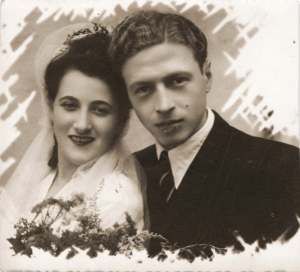Regina Goodman and Sam Spiegel’s first meeting and early relationship had many hallmarks of ordinary teenage love: friendship, flirting and finding ways to be alone together.

Courtesy of United States Holocaust Memorial Museum and William and Helen Luksenburg
Less ordinary is the fact that they met in a forced labor camp in Pionki, Poland, during the Nazi occupation.
The United States Holocaust Memorial Museum shared their love story during “Acts of Resistance: Love Stories and the Holocaust.” The Facebook Live event, which was hosted by museum historians Lindsay MacNeill and Edna Friedberg, was part of the Stay Connected project, a series of Holocaust education webinars created in the absence of in-person programming.
MacNeill said Goodman and Spiegel found ways to meet and talk at the water spigot even though men and women were supposed to be kept apart.
“One time, Sam said he received 12 lashes for talking to Regina, but he said it was worth it,” she said.
The young lovers were separated at the end of the war when the Germans loaded prisoners onto cattle cars and transported them to Auschwitz-Birkenau. Before they were forced into their gender-segregated sections of the concentration camp, Spiegel told Goodman to meet him in his hometown, Kozienice, if she survived. They were moved around various labor camps until liberation, when they returned to their respective hometowns to search for their families.
When Spiegel learned Goodman had survived, he sent a horse and buggy to bring her to Kozienice, and the two were married in a displaced persons camp in Germany shortly after. They stayed together for 70 years.
William Luksenburg and Helen Chilewicz met under similar circumstances, talking through a fence in the Gleiwitz labor camp between their barracks and writing letters to each other. Luksenburg promised Chilewicz that they would survive the war and he would marry her.
His prediction came true, and they wed in a displaced persons camp in 1947. During the ceremony, the rabbi recited a prayer in honor of their family members, most of whom had been murdered, and the couple bowed their heads in grief. They later immigrated to the United States and became volunteers at the USHMM.
MacNeill also told the story of an interfaith family whose love helped save Jewish members from deportation.
When the Nazis came to power, they encouraged Aryan women with Jewish husbands to divorce their spouses in the name of racial purity. Hedwig Gluckstein, however, refused to leave her Jewish husband, Georg Gluckstein, and their son Fritz. When father and son were rounded up by the Gestapo in Berlin, she joined hundreds of other Aryan women outside the detention center in what became known as the Rosenstrasse Protest to demand the release of their loved ones.
Everyone in the center was eventually released. Although Georg and Fritz Gluckstein had to perform forced labor, they were not deported to death camps.
“Of the 73,000 Jews who were living in Berlin in October of 1941 when deportations began, only 8,300 survived the Holocaust. And of that small number, half of them were in these types of intermarried families, they were married to somebody who was categorized as Aryan or they were categorized like Fritz as mixed race. So Hedwig and women like her, who stayed in these marriages, this act of love might have really saved the lives of thousands of people,” she said.
Many other couples did not make it through the war.
MacNeill said LGBTQ couples were especially vulnerable, and gay men were persecuted as enemies of the Reich.
Gad Beck and Manfred Lewin managed to have a romance in the midst of tragedy. They met in a Jewish youth group and signed up for air raid patrol so they could spend time alone together. MacNeill and Feinberg showed a booklet of love notes and sketches Lewin created for Beck, which now sits in the museum’s archives.
“Night exists for more than sleep which is why, my love, we stayed awake so often,” an excerpt reads.
When Lewin and his family were summoned for deportation, Beck donned a Hitler Youth uniform and demanded a meeting with him (he was protected by his half-Aryan status.) Once he and Lewin were alone, he begged him to run away with him and go into hiding, but Lewin wouldn’t leave his family. They boarded a train east, and Beck never saw his love again; records show Lewin and his family were gassed at Auschwitz.
Friedberg posted a link to Lewin’s booklet for viewers to examine.
“You can actually kind of do a flipbook, go through it and see the various drawings, the passionate, romantic, maybe not the most sophisticated teenage love poetry that’s in there, but something that just really drives home what this relationship meant as a solace and sustenance to these teenagers,” she said.



